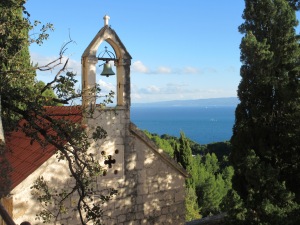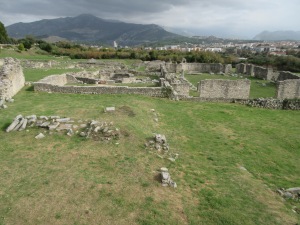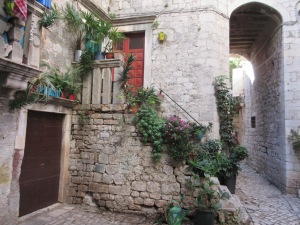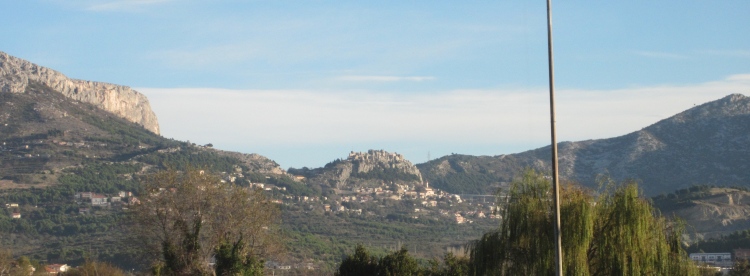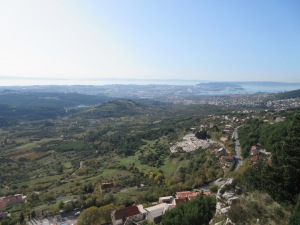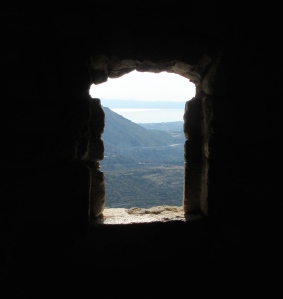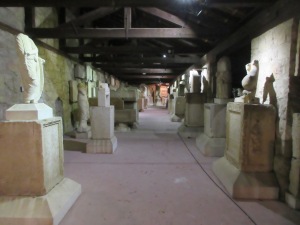You can now see a map of the places we have been by clicking “Map” at the top of your screen or here.
It is time to say goodbye to Croatia. Emotions are always mixed at times like this. On one hand, we have barely scratched the surface of what Croatia is about. On the other hand, we have figured out how to get around. We now know how to read the bus schedule, that counting always starts with the thumb (so if you hold up your pointer and middle finger at the market to indicate you want two pomegranates, you’ll get three every time), and that very few answers can be found on Google because only a quarter of Croatians use the internet. It’s time to say goodbye to this beautiful place and these kind people. Croatia has only been independent since 1991 and a member of the EU for about a year. Croats have called this home since the seventh century; they are proud of their heritage, their country, and their progress in the last few decades.
It is also time to look forward to what comes next with anticipation: new words, new flavors, new customs, new idiosyncrasies, new stories. Before we sign off from Croatia, there are a few last day-trips to share. We were able to get to all these places on public transportation.
The Romans built a city just a couple miles from Split that they inhabited from 200BC to 600AD. At it’s peak, Salona had 60,000 residents. Emperor Diocletian was born there. Today the town of Solin is built around these ruins. One afternoon when the grey clouds were piling up against the Dinaric Alps, we checked out what is left of ancient Salona. Like we’ve seen in Split, the oldest buildings in town were often demolished to contribute to newer projects. The original heart of the city was the Forum. As Christianity became widespread, the church became the new heart. In the 1700s, the Venetians had the three-story, 17,000-seat coliseum’s walls destroyed so it couldn’t be used as a base by the invading Ottomans. Today a freeway runs through what would be backstage at the theater. Farmers grow crops in the flat spaces and mark their fields with ancient stone walls, houses and sheds are sprinkled among the ruins, vast areas are overgrown with weeds. Time marches on. Some of our favorite places in the ruins of Salona were a five-arched bridge, the thermal baths, the coliseum built for gladiator games, the aqueduct integrated into the defensive city wall, and rows of sarcophogi.

Klis sits on top of a steep hill. Note the hot oil port (and greasy streak) in the lower left hand quadrant.
The TV show Game of Thrones has done much filming in Croatia and brought deserved notoriety to the Klis Fortress. An easy pass through the Dinaric Alps has a steep rocky pile of a ridge in the middle of it. The earliest people in this area used it as a lookout and simple fort due to its strategic location. Over the last couple millenia, every other ruling party has adopted Klis, often adding on to it. It is a defensible fort and has seen plenty of battle. Greeks and Romans used it to keep an eye on boat traffic, the Mongols attacked it, and many Croatian kings called it home. It’s most recent military occupation was the Germans during WWII until they were pushed out of Croatia by the Partisans in 1944. Small cracks of windows cover the walls. Walls and gates stack up nesting inside each other four defensive perimeters deep, keeping the innermost area very safe. Views are nearly vertical and clearly show all traffic through the pass as well as in the waters around Split and the nearby islands. We crawled through the narrow archer’s passages, gawked at a hole for dropping hot oil on invaders, looked over the shoulders of a crew of archeologists in the midst of an excavation, and ate our picnic lunch presiding over the land.
Trogir is a village built on a small island. Today the town slops over onto the shore on both sides but the old village came complete with it’s own natural moat. Trogir is a stone’s throw from the mainland on one side and a slingshot throw from a larger island on the other side. It is the quintessential white-stone, red-roof, medieval village and is well preserved. A fort with crenellated walls stands at one end of the island, looming over a soccer field. The day we visited was cool, quiet, and nearly deserted. Almost every business we passed was closed for the winter. Eventually, we found a bakery open to sell us lunch and a business open that had a toilet we could use. We reverse followed the steps of cone-licking shopkeepers to find the ice cream shop. We walked the docks filled with a hundred charter boats getting winterized. On the hill above Trogir is a marble quarry, distinct from other quarries for its smooth sawn vertical walls.
November has almost come to an end. Split residents are still swimming and sun-bathing in the warmth of the afternoon. Outdoor cafe seating continues to be packed when the sun shines. Thunderstorms have passed through almost every night this last week. We took the train back across the country to Zagreb, where we’ll catch our flight out. The countryside is beautiful: many small farms, forests, rivers, a seemingly random fortress on a hill, hawks and herons. Goodbye, Croatia!
We added more pictures to the Croatia photo gallery from these adventures and our last few days. The new pictures are at the bottom.
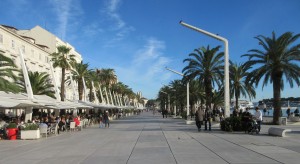
The Riva in Split, almost a kilometer long. Cafes line the left side, full of locals in the off-season November sunshine. On the right are benches and mini-parks.

One of the original entrances to Salona. Note the grooves from wagon wheels in the rock. A two-story tower stood over the gate.

The gladiator’s entrance to the coliseum. Openings between columns on right and left held animal cages.
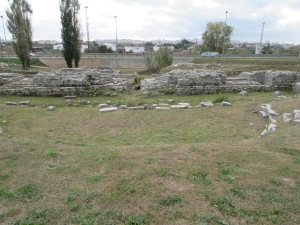
Salona’s theater and forum, the oldest center of this Roman city, now have front-row seats to the freeway.

Megan enjoys the hottest sauna in the Salona thermal baths. Note the indented circle and drain on the floor.

The aqueduct crossed this gate. Large flagstones supported its weight over the span, visible in the upper part of this photo. Salona.

Later construction in the city of Salona incorporated unused buildings. In this 4th-century basilica, you can see pieces of columns and thresholds used to create walls.
